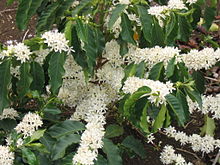| Coffea arabica | |
|---|---|

| |
| Coffea arabica flowers | |

| |
| Coffea arabica fruit | |
| Scientific classification | |
| Kingdom: | Plantae |
| Clade: | Tracheophytes |
| Clade: | Angiosperms |
| Clade: | Eudicots |
| Clade: | Asterids |
| Order: | Gentianales |
| Family: | Rubiaceae |
| Genus: | Coffea |
| Species: | C. arabica
|
| Binomial name | |
| Coffea arabica | |
Coffea arabica (/əˈræbɪkə/), also known as the Arabica coffee, is a species of flowering plant in the coffee and madder family Rubiaceae. It is believed to be the first species of coffee to have been cultivated and is the dominant cultivar, representing about 60% of global production.[2] Coffee produced from the less acidic, more bitter, and more highly caffeinated robusta bean (C. canephora) makes up most of the remaining coffee production. The natural populations of Coffea arabica are restricted to the forests of South Ethiopia and Yemen.[3][4]
- ^ Moat, J.; O'Sullivan, R.J.; Gole, T.W.; Davis, A.P. (2020). "Coffea arabica". IUCN Red List of Threatened Species. 2020: e.T18289789A174149937. doi:10.2305/IUCN.UK.2020-2.RLTS.T18289789A174149937.en. Retrieved 19 November 2021.
- ^ "Coffee: World Markets and Trade" (PDF). United States Department of Agriculture – Foreign Agricultural Service. 16 June 2017. Archived from the original (PDF) on 8 December 2017. Retrieved 8 December 2017 – via Cornell University.
- ^ Meyer, Frederick G. 1965. Notes on wild Coffea arabica from Southwestern Ethiopia, with some historical considerations. Economic Botany 19: 136–151.
- ^ Söndahl, M. R.; van der Vossen, H. A. M. (2005). "The plant: Origin, production and botany". In Illy, Andrea; Viani, Rinantonio (eds.). Espresso Coffee: The Science of Quality (Second ed.). Elsevier Academic Press. p. 21. ISBN 978-0-12-370371-2.
